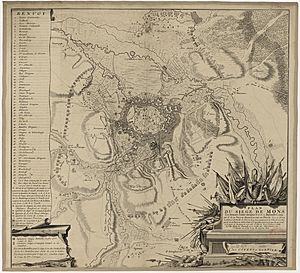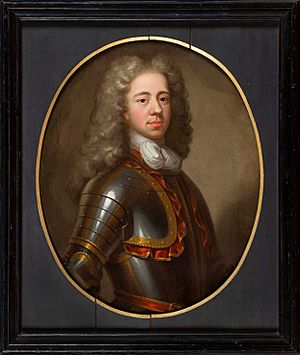Siege of Mons (1709) facts for kids
Quick facts for kids Siege of Mons |
|||||||
|---|---|---|---|---|---|---|---|
| Part of the War of the Spanish Succession | |||||||
 A plan of the siege of Mons in 1709 |
|||||||
|
|||||||
| Belligerents | |||||||
| Commanders and leaders | |||||||
|
|||||||
| Strength | |||||||
| 10,000 | 4,280 | ||||||
| Casualties and losses | |||||||
| 2,200 | 700 | ||||||
The Siege of Mons was an important battle that happened between September 19 and October 23, 1709. It was part of a bigger conflict called the War of the Spanish Succession. During this siege, a group of soldiers from France and Spain defended the strong town of Mons. At that time, Mons was in a region known as the Spanish Netherlands, which is now part of Belgium.
The attackers were from the Grand Alliance army. This army included soldiers from the Dutch Republic, Great Britain, and the Habsburg monarchy. They were led by famous generals like the Duke of Marlborough and the Prince of Orange.
Just before the siege, a huge battle called the Battle of Malplaquet took place on September 11, 1709. The French commander, Duke of Villars, tried to stop the Grand Alliance from reaching Mons. Even though the Grand Alliance won, they lost many soldiers. After this battle, more Allied soldiers joined the siege of Mons. The French and Spanish soldiers defending Mons finally gave up in October. Because so many soldiers were lost at Malplaquet, the capture of Mons was the last major fight of 1709 in this war.
Why Mons Was Important
After a long and difficult siege, the Grand Alliance captured the town of Tournai on September 3, 1709. Right after this victory, the Duke of Marlborough quickly moved his army towards Mons. They believed that taking Mons and its strong fortress would allow them to move into northern France.
The French commander, Duke of Villars, had thought the Allies would go towards Ypres. He quickly changed his plans and asked Louis XIV, the King of France, for permission to attack. King Louis XIV was very upset about losing Tournai. He ordered Villars to make sure Mons was not captured. He told Villars that if Mons fell like Tournai, their cause would be lost, and he should do everything to help the soldiers defending it, no matter the cost.
The fortress of Mons was commanded by the Marquis de Grimaldi. He had about 4,280 soldiers. Most of these were Spanish troops, with some Bavarians and French soldiers who had joined after Tournai fell. However, this group was not big enough to fully defend all the town's strong walls.
The defenses at Mons were very impressive. The town had a large wall with 18 to 20 ravelins (triangle-shaped forts). It was also surrounded by two ditches filled with water from two rivers. Part of the town was on a hill, and there was a lot of swampy land around it. This swampy area could be flooded using a system of water locks, making it even harder for attackers to get close.
On September 3, while the surrender of Tournai was still being worked out, Marlborough sent a small group to check Mons' defenses. On September 6 and 7, the Prince of Hesse-Kassel arrived with cavalry and infantry to block the road to Mons. More cavalry soon joined them. By September 8, Marlborough was southwest of Mons, and Eugene of Savoy was to the west.
On September 9, Duke of Villars and Marshal Boufflers took positions southwest of the Allied forces. To remove this threat to the siege, Marlborough ordered an attack on Villars' strong positions. This led to the very costly Allied victory at the Battle of Malplaquet on September 11, 1709.
The Siege Begins
After the French threat was dealt with at Malplaquet, Marlborough and Eugene ordered the Prince of Orange to surround Mons. This was completed on September 19 and 20. The Prince's force had about 30 battalions, including at least 14 Dutch and 4 British, totaling around 10,000 soldiers. Three French battalions had managed to sneak into Mons from Malplaquet to help defend it.
On September 24, the Prince of Orange attacked the outer defenses of the fortress. The next day, Eugene arrived with the main part of the Allied army. King Louis XIV had told Boufflers not to risk another big battle, so the French did not try to rescue Mons once the siege had started.
On the night of September 26, the Allies tried a two-part attack on the fortress. However, many soldiers got lost in the dark. The defenders only noticed them when the moonlight appeared, which led to many Allied soldiers being killed or wounded.
The Allies began digging trenches and setting up artillery guns. But heavy rain and constant shelling from the defenders made the work very difficult. Both Cadogan and Richard Molesworth were injured. On October 10, Marlborough wrote a letter saying how frustrated he was with the weather. To fix the problem, Allied troops dug ditches to drain water into the Trouille river and used fascines (bundles of sticks) to make the ground stronger.
The French and Spanish defenders tried a sortie (a sudden attack) with 300 soldiers. They fought a British regiment before being pushed back by more Allied troops. On October 16, the Allies successfully attacked the counterscarp (an outer wall) near the Gate of Havre, but it was a costly fight.
On October 19, the Allied artillery redoubt (a small fort) was finished, and their powerful cannons were ready. That morning, the cannons began firing at the town's defenses, causing a lot of damage. At noon on October 20, the commander of Mons, Grimaldi, saw the Allies preparing for a final attack. He sounded the chamade (a signal to surrender) and said he wanted to give up. On October 23, the French and Spanish accepted the Allied terms. The remaining 1,500 soldiers left Mons with the honours of war (meaning they could keep their flags and weapons), but they had to leave their cannons and mortars behind.
What Happened Next
After Mons was lost, the French and Spanish armies had to leave the area between the Sambre and Meuse rivers. The local government of the County of Hainaut, whose capital was Mons, recognized Charles VI, Holy Roman Emperor as the new King Charles III of Spain.
Because both the French and Allied armies had suffered so many losses at the Battle of Malplaquet, the capture of Mons was the last major battle of the 1709 fighting season. After this, the Allied armies went into their winter quarters until the war continued in 1710.


